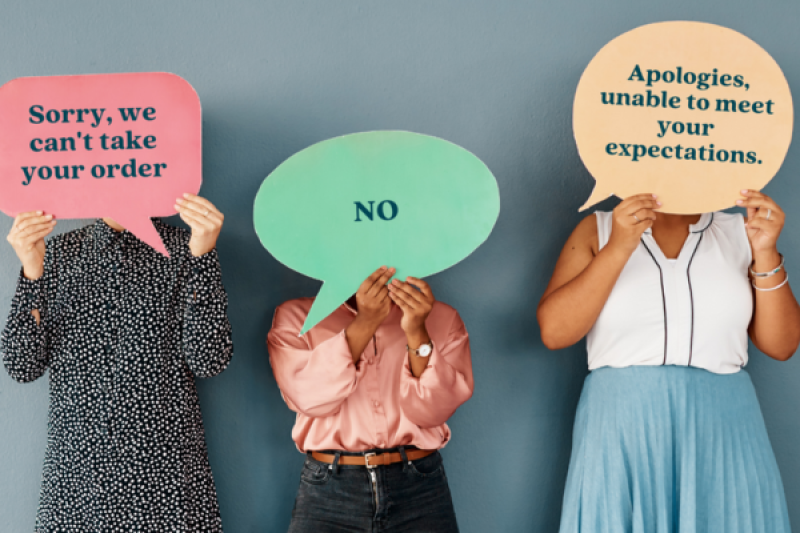Don't Sugar-Coat It: A Guide to Saying No Gracefully


Introduction
Running a small home-based baking business can be rewarding, but it also comes with its fair share of challenges. One of those challenges is dealing with problematic cake orders and difficult customers. While it's important to provide excellent customer service, there are instances where saying no becomes necessary. This article aims to guide bakers in politely declining cake orders in three common scenarios: customers who have paid a deposit, customers who keep changing their minds, and customers who seem to be wasting time by constantly seeking quotes without committing.
Customers Who Seem to be Wasting Time
Some customers may repeatedly request quotes and samples without ever committing to an order. This behaviour can be frustrating and time-consuming for a small business. In such cases, it's essential to set boundaries and address the issue directly.
For instance: "I appreciate your interest in my cakes. However, I've noticed that you've been continuously requesting quotes without placing an order. As a small business, my time and resources are valuable. If you are serious about placing an order, please let me know by [specific date]. If I don't hear from you by then, I'll assume you are no longer interested, and I'll focus on other customers."
It's crucial to value your time and ensure that you are dedicating it to customers who are genuinely interested in your products and services. By politely but firmly setting a deadline, you communicate your expectations and encourage potential customers to make a decision. If they fail to respond within the given timeframe, it's reasonable to prioritise other customers who are ready to commit.

Customers Who Keep Changing Their Mind
Dealing with customers who constantly change their cake design or request modifications can be frustrating and time-consuming. It's important to establish boundaries and communicate the potential impact on the order.
You can use this approach: "I want to remind you that the initial quote you received was based on the original design. Any changes made may incur additional costs. However, if the changes continue, I must be honest and express my concern about meeting your expectations. Due to the number of changes and requests, I am not confident that I'll be able to fulfill your order to your satisfaction."
In such situations, it's essential to have a candid conversation with the customer. Explain the importance of sticking to the agreed-upon design and its impact on both the timeline and the final product. By clearly communicating your concerns, you give the customer an opportunity to reassess their requirements and evaluate their commitment to the order. If necessary, provide them with a reasonable deadline to finalise their design choices, allowing you to move forward with the order effectively.
Customers Who Have Paid a Deposit
When a customer has already paid a deposit but their expectations or demands become unmanageable, it's crucial to address the situation with care. Start by acknowledging their investment and express your concerns about meeting their expectations.
It's important to emphasise that as a small business owner, your primary goal is customer satisfaction. However, if you genuinely believe that you won't be able to meet their expectations or provide the desired outcome, it's better to part ways amicably. By offering a refund, you demonstrate professionalism and respect for your customer's needs.

Things to include in your response:
Parting ways with a customer and declining a cake order can be challenging, but it's important to handle the situation gracefully and professionally. When communicating the decision, consider incorporating the following key points:
- Express Regret and Inability to Fulfill the Order: Start by expressing regret and acknowledging the customer's interest in your cakes. Be honest and straightforward about your inability to fulfill their specific order. Explain that, after careful consideration, you have determined that you cannot meet their expectations.
- Offer a Full Refund: Assure the customer that you value their satisfaction and want to provide a solution that best serves their needs. Offer a full refund of their deposit without hesitation. Emphasise that this refund will allow them to explore other options and find a baker who can meet their requirements.
- Apologise for Any Inconvenience: Take the opportunity to apologise for any inconvenience caused by the inability to fulfill the order. Show empathy and understanding towards the customer's expectations. Reiterate that your goal is to ensure their event is a success, even if it means redirecting them to another baker.
- Provide Clear Instructions for the Refund Process: To facilitate a smooth transition, provide clear instructions on how the customer can proceed with the refund. Request the necessary details for processing the refund, such as their preferred payment method and relevant information. Assure them that you will handle the refund promptly and efficiently.
- Maintain Professionalism and Positive Tone: Throughout the communication, maintain a professional and positive tone. Avoid blaming or criticising the customer for their expectations or changes to the order. Focus on finding a solution that best serves both parties, even if it means parting ways.
Remember, by approaching the situation with empathy, honesty, and professionalism, you can maintain a positive reputation and prioritise customer satisfaction, even when declining a cake order.

Conclusion
As a small business owner, you have the right to decline cake orders that are not a good fit for your bakery. By politely and honestly communicating your concerns to customers, you can protect your time, resources, and overall customer satisfaction. Remember to always remain professional and offer alternative solutions when possible. By mastering the art of saying no gracefully, you can maintain a positive reputation while prioritising your business's success.
Handling problematic cake orders requires tact, clear communication, and understanding. While saying no can be difficult, it is sometimes necessary to maintain the quality of your work and the satisfaction of your customers. By following the guidelines provided in this article, you can navigate challenging situations and create a more productive and rewarding business environment.